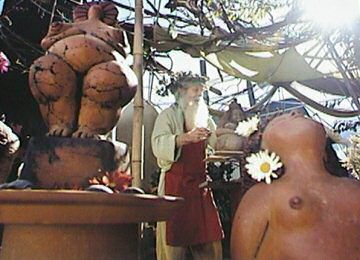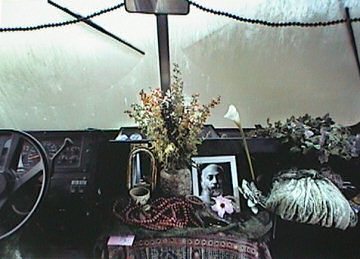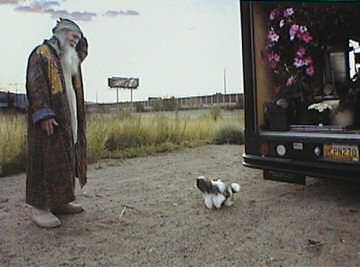
IT'S A LOVE DANCE
by Nancy Salem for LA VIDA, The Albuquerque Tribune
[photos by Stacia Spragg/ Tribune]
For goddess maker Anand Naren, the journey to his current state of bliss
-
making garden art - was as important as his destination.

Goddess maker Anand Naren works on a clay sculpture in his booth at the Tesuque Pueblo Flea Market. Naren designs his booth with plants, flowers and other garden elements. "I feel more at home in a rain forest than in the desert," he says.
god-dess (god'iss) 1:
a divinity or deity of the female sex
2:
a woman who is the object of adoration
3:
a woman of great charms
TESUQUE PUEBLO - From a distance you see the green leaves of a tree, leaves that glimmer in the sea of treasures that is the Tesuque Pueblo Flea Market. You fix on the color and walk closer. Flowers, plants, river stones and bird baths take shape: a garden among the shops. There she is among the splendor, a desert mermaid hanging from terra cotta beads, a seated mystic with clay birds nesting in her hair and hands, a Medusa whose dancing calms the serpents, an equestrienne whose head is thrown back in joy, a laughing beauty, an Earth Mother, a fertility icon, a dreamer...
These goddesses - and this lush grotto- are the creations of Anand Naren, He's Pan and Bacchus, head adorned with leaves and vines, a silver beard, flowing robes and a twinkle in his eye. He plays the part of the green man of medieval lore, a devotee and sometime consort of the great mother, the goddess.
"To me, the goddess represents living life with receptivity, living life with an open hand rather than a closed fist, being
available to whatever is happening in the moment," says Naren, a 60 something artist whose spiritual and artistic journey
led him to New Mexico eight years ago. "The goddess is about laughter, about letting it be. I consider that the goddess
and I are in a dance together. It's a love dance."
Naren's goddesses, which he sells primarily on weekends at the Tesuque market north of Santa Fe, range from tiny
figures on sticks to statuesque sculptures standing several feet high. Intended for gardens, they are formed of richly
textured, fired clay. Made to Order, one at a time. These aren't skinny girls. The full, round figures are inspired
by ancient images of goddesses, and by prehistoric are such as the Venus of Willendorf.
They cost from $15 to $650.00 The wait for a Naren goddess can range from three to nine months.
"It pleases me immensely to know that when I leave this Earth, there will be thousands of goddesses left behind in
beautiful gardens all over the world" he says.
Naren was drawn to the goddess image as a young artist, born Thomas Pope, in North Carolina. I always wanted
to be an artist," he says. "As a child, I played with dolls for hours on end. Looking back, those dolls were my first
goddesses. The goddess has been a constant in my life since the beginning."
Naren received bachelor's and master's degrees in art from Virginia Commonwealth University in the 1960's, and
began an odyssey that took him to Louisiana, California, Hawaii and Tennessee in search of his artistic roots.
|

| Anand Naren's truck, which he describes as "Sarafina, the Italian working girl goddess," features an altar in the front with a portrait of Naren's guru, Osho Rajneesh.
|
"I was a gypsy sort," he says. "I tended to live in one place three years then travel on.
He changed mediums as often as addresses, working in painting, woodcarving, photography and silkscreen.
Naren left art in the early 1970's to become a monk in a Hindu monastery in San Francisco. "I had always been
searching for something," he says. "I happened to fall in tune with the teachings of an orthodox guru and spent seven
years as his monk. Shaven head, vows of celibacy, obedience, poverty."
The life became too restrictive. "I couldn't do art," he says. There came a time when it wasn't possible for me anymore.
I moved back into the world because I had to dance."
Naren left the monastery and resumed life as an artist in San Francisco. Two years later, in the late 1970's, he became
a disciple of the mystic Osho Rajneesh, whose teachings he continues to follow. Rajneesh gave Thomas Pope the name
Anand Naren, which means "bliss king" in Hindi. "Meeting this spiritual master has been the supreme blessing of my life,"
Naren says.
He left San Francisco a few years later to teach, first in special education in Knoxville, Tenn, and later as head of the art
department at Knoxville College. There he met a fellow artist, Stephanie Turner, whom he followed to New Mexico
eight years ago.
"As 'real' jobs go, teaching is about the best you can do as an artist," Naren says. "But it seems I attended one too many
faculty meetings. I quite literally tore up my résumé and came to the Southwest intent on making my way as an artist."
In Knoxville, Naren had discovered clay. "I held it in my hands and knew that I had come home," he says. "It was mine.
When I was a painter, I was a space cadet. Clay literally grounds me, brings me to the Earth.:"
Naren had designed a few garden goddesses in Knoxville. After settling in Albuquerque, he took them to the Tesuque
flea market, doing business as Sacred Garden Gallery.
"When I came out here, life had her own agenda which wasn't quite as clear-cut as my impulse was, which is to say that I
had a very hard time at the beginning," he says. But, he persevered, creating more goddesses and adorning his space at the
flea market. "For the first few years as a goddess maker, I felt like some sort of strange cosmic joke," he says. "I was making
the image of an abundant fertility goddess and living in poverty."
His figures gradually found a market and business has grown the past five years. His clientele includes local and worldwide
buyers.
Naren offers about 10 different goddess figures at any one time. While some are retired, others are born. A new goddess is
designed in solid clay. "When she is just right, I make a plaster or flexible rubber mold of the basic form," Naren says. "With
the mold, I can reproduce the basic form."
The clay that goes into the mold is mixed with organic materials, such as coffeechaff, sawdust and grasses. The materials burn
away in the process of firing, leaving a textured surface that looks aged. Then the real work begins. On a large goddess, Naren
spends about 10 hours creating the face, hair, other features and each goddess's "undefinable spirit." "I do believe with all my heart that a subtle energy comes through the goddess, because I am totally in the present while working on her," he says. "If I've done 100 of that goddess before, she is still the first. This is at the core and base of where I'm coming from, being present in the moment."
|

| Anand Naren talks with his Shih Tzu, Mai-Mai, as he loads his truck with Goddesses and flowers at his home in the North Valley. Every weekend he goes to the Tesuque Pueblo Flea Market, where he sells his sculptures.
|
Ann Winters, an Albuquerque customer, says she can feel the spirit and energy in Naren's goddesses. She recently bought Pomona, a standing goddess who floats above a base, her peaceful, smiling face tilted skyward, hands behind her back.
"I've seen Naren's goddesses for years and always wanted one," she says. "I finally ordered one earlier this year and didn't mind the wait. Even before I got her, I thought of her as real in some way. It sounds weird, but she really does have a sweet and positive energy. She stands in a garden outside a window, and every time I look I smile."
Naren has models of the goddesses at the flea market and on his web site- www.sacredgardengallery.com - where customers place orders. "My business is going so well now that I could afford to hire people to help me," Naren says, " But I will never, ever, ever do that. Someone like me can never become a factory. I'm too particular. I have to be present at every stage of the process, from wedging the clay to fashioning the nose to shipping. I am there, not in another place." That thinking extends to Naren's choice of the flea market as a place of business. "As an artist, I relate to the dance between myself, the goddess and the patron," he says. There's an energy sharing that can occur in such a setting as the flea market, a warm human experience. A gallery separates the artist from the art. In that separation is the loss of the organic wholeness in which I live my life."
Naren says he's grateful for his success, but would be making goddesses regardless. "I've been given abundance by being a goddess maker," he says. "But I know now that success is doing what you absolutely love to do, and doing it whether it gives back or not. Just doing it is being given back."
Naren says his early, painted images showed tormented goddesses trying to escape from cages. Those goddesses were a reflection of his own torment as a young man. His goddesses now are smiling and at peace, a reflection of Naren today.
"What I do is a direct expression of who I am and what I am inside," he says. "It's hard not to sound hokey, but I find everything that has led me to the place where I am to have been beautiful. Even the suffering I went through as a young, tortured, angry artist went with the territory. "That I can recall this tortured young artist now as a 60-something, blissed out goddess maker gives me tremendous satisfaction. It is a testament to the fact that transformation is possible."
|
|

